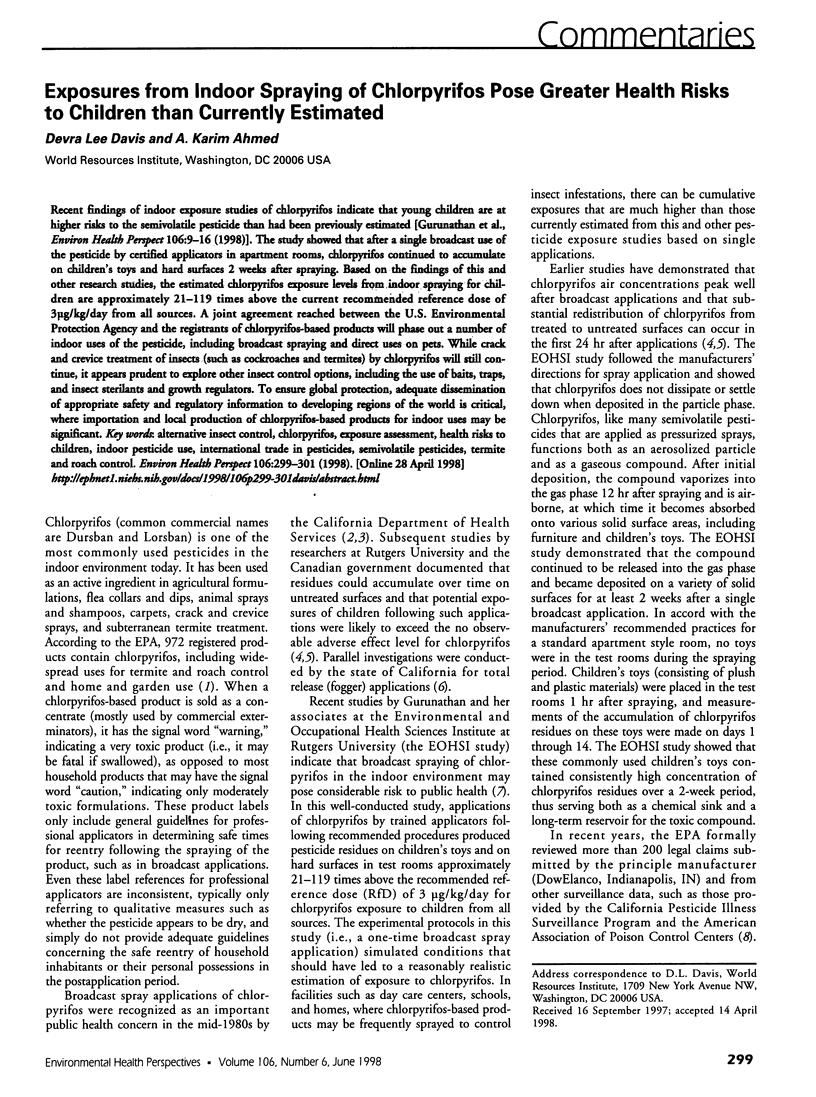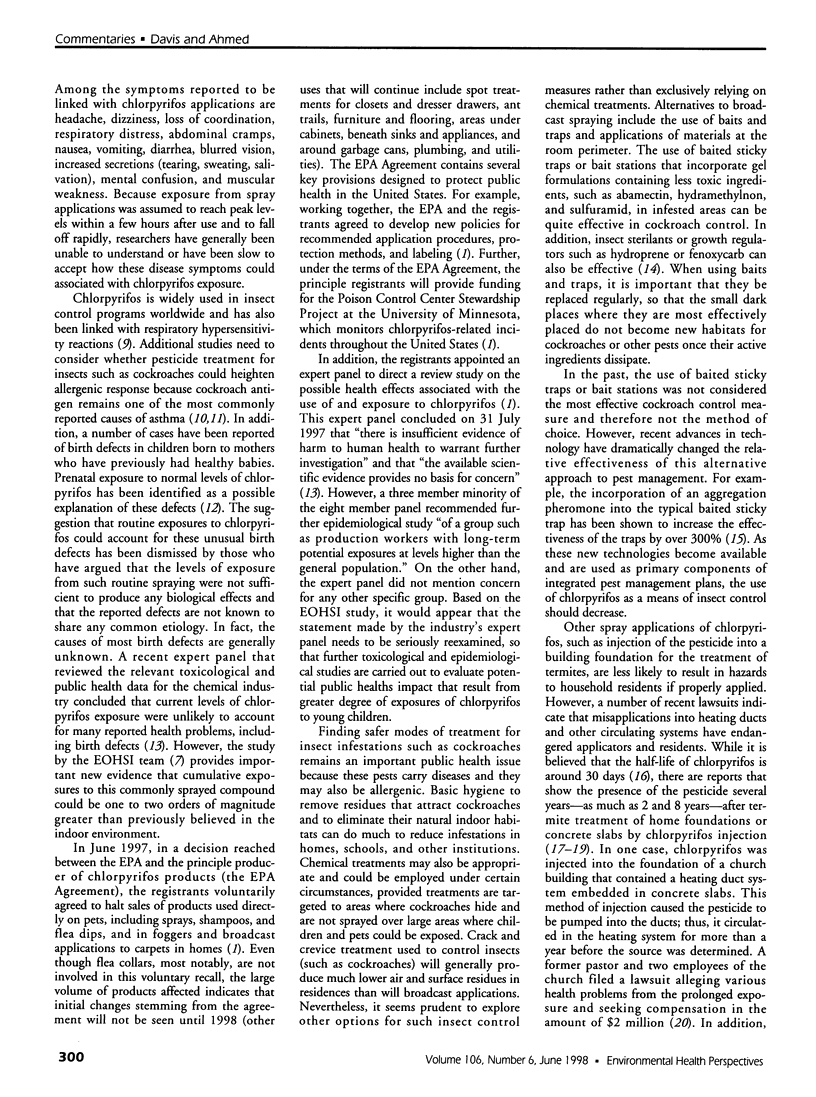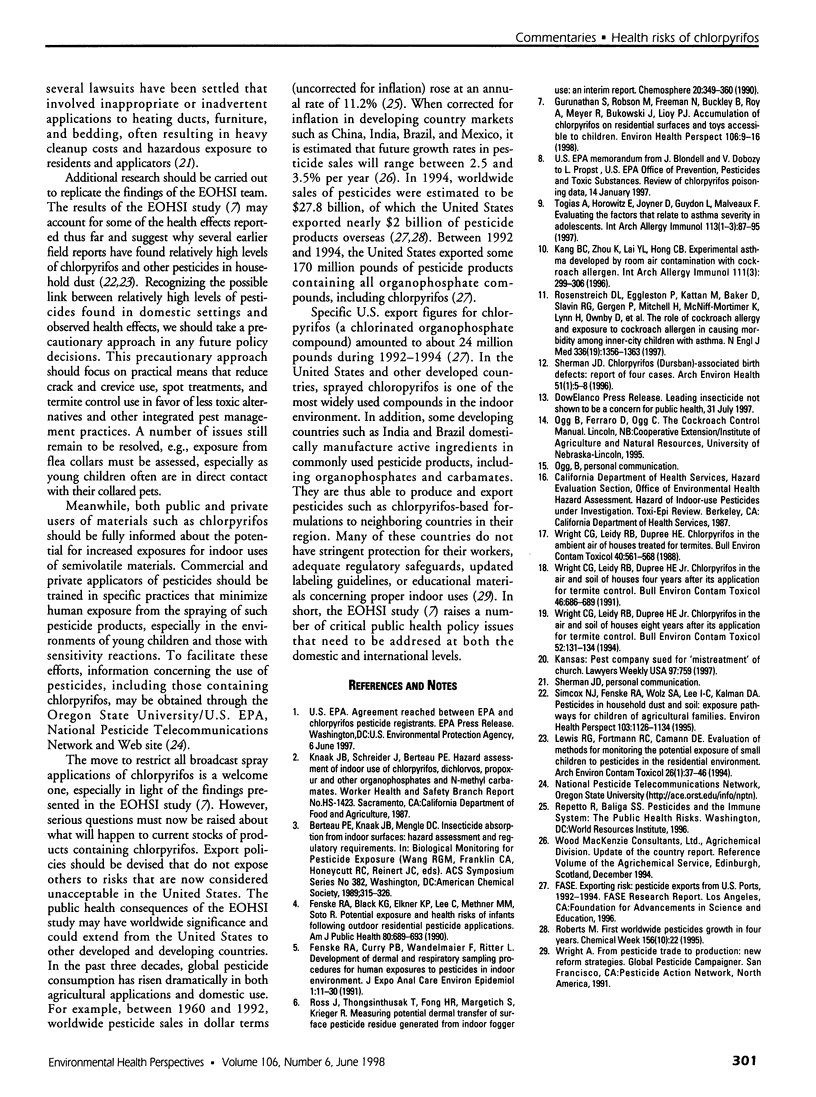Abstract
Recent findings of indoor exposure studies of chlorpyrifos indicate that young children are at higher risks to the semivolatile pesticide than had been previously estimated [Gurunathan et al., Environ Health Perspect 106:9-16 (1998)]. The study showed that after a single broadcast use of the pesticide by certified applicators in apartment rooms, chlorpyrifos continued to accumulate on children's toys and hard surfaces 2 weeks after spraying. Based on the findings of this and other research studies, the estimated chlorpyrifos exposure levels from indoor spraying for children are approximately 21-119 times above the current recommended reference dose of 3 microg/kg/day from all sources. A joint agreement reached between the U.S. Environmental Protection Agency and the registrants of chlorpyrifos-based products will phase out a number of indoor uses of the pesticide, including broadcast spraying and direct uses on pets. While crack and crevice treatment of insects (such as cockroaches and termites) by chlorpyrifos will still continue, it appears prudent to explore other insect control options, including the use of baits, traps, and insect sterilants and growth regulators. To ensure global protection, adequate dissemination of appropriate safety and regulatory information to developing regions of the world is critical, where importation and local production of chlorpyrifos-based products for indoor uses may be significant.
Full text
PDF


Selected References
These references are in PubMed. This may not be the complete list of references from this article.
- Fenske R. A., Black K. G., Elkner K. P., Lee C. L., Methner M. M., Soto R. Potential exposure and health risks of infants following indoor residential pesticide applications. Am J Public Health. 1990 Jun;80(6):689–693. doi: 10.2105/ajph.80.6.689. [DOI] [PMC free article] [PubMed] [Google Scholar]
- Fenske R. A., Curry P. B., Wandelmaier F., Ritter L. Development of dermal and respiratory sampling procedures for human exposure to pesticides in indoor environments. J Expo Anal Environ Epidemiol. 1991 Jan;1(1):11–30. [PubMed] [Google Scholar]
- Gurunathan S., Robson M., Freeman N., Buckley B., Roy A., Meyer R., Bukowski J., Lioy P. J. Accumulation of chlorpyrifos on residential surfaces and toys accessible to children. Environ Health Perspect. 1998 Jan;106(1):9–16. doi: 10.1289/ehp.981069. [DOI] [PMC free article] [PubMed] [Google Scholar]
- Harf L., Arch S., Eskin A. Polypeptide secretion from the eye of Aplysia californica. Brain Res. 1976 Jul 30;111(2):295–299. doi: 10.1016/0006-8993(76)90774-5. [DOI] [PubMed] [Google Scholar]
- Kang B. C., Zhou K., Lai Y. L., Hong C. B. Experimental asthma developed by room air contamination with cockroach allergen. Int Arch Allergy Immunol. 1996 Nov;111(3):299–306. doi: 10.1159/000237381. [DOI] [PubMed] [Google Scholar]
- Lewis R. G., Fortmann R. C., Camann D. E. Evaluation of methods for monitoring the potential exposure of small children to pesticides in the residential environment. Arch Environ Contam Toxicol. 1994 Jan;26(1):37–46. doi: 10.1007/BF00212792. [DOI] [PubMed] [Google Scholar]
- Rosenstreich D. L., Eggleston P., Kattan M., Baker D., Slavin R. G., Gergen P., Mitchell H., McNiff-Mortimer K., Lynn H., Ownby D. The role of cockroach allergy and exposure to cockroach allergen in causing morbidity among inner-city children with asthma. N Engl J Med. 1997 May 8;336(19):1356–1363. doi: 10.1056/NEJM199705083361904. [DOI] [PubMed] [Google Scholar]
- Simcox N. J., Fenske R. A., Wolz S. A., Lee I. C., Kalman D. A. Pesticides in household dust and soil: exposure pathways for children of agricultural families. Environ Health Perspect. 1995 Dec;103(12):1126–1134. doi: 10.1289/ehp.951031126. [DOI] [PMC free article] [PubMed] [Google Scholar]
- Togias A., Horowitz E., Joyner D., Guydon L., Malveaux F. Evaluating the factors that relate to asthma severity in adolescents. Int Arch Allergy Immunol. 1997 May-Jul;113(1-3):87–95. doi: 10.1159/000237515. [DOI] [PubMed] [Google Scholar]
- Wright C. G., Leidy R. B., Dupree H. E., Jr Chlorpyrifos in the air and soil of houses eight years after its application for termite control. Bull Environ Contam Toxicol. 1994 Jan;52(1):131–134. doi: 10.1007/BF00197368. [DOI] [PubMed] [Google Scholar]
- Wright C. G., Leidy R. B., Dupree H. E., Jr Chlorpyrifos in the air and soil of houses four years after its application for termite control. Bull Environ Contam Toxicol. 1991 May;46(5):686–689. doi: 10.1007/BF01689953. [DOI] [PubMed] [Google Scholar]
- Wright C. G., Leidy R. B., Dupree H. E., Jr Chlorpyrifos in the ambient air of houses treated for termites. Bull Environ Contam Toxicol. 1988 Apr;40(4):561–568. doi: 10.1007/BF01688381. [DOI] [PubMed] [Google Scholar]


